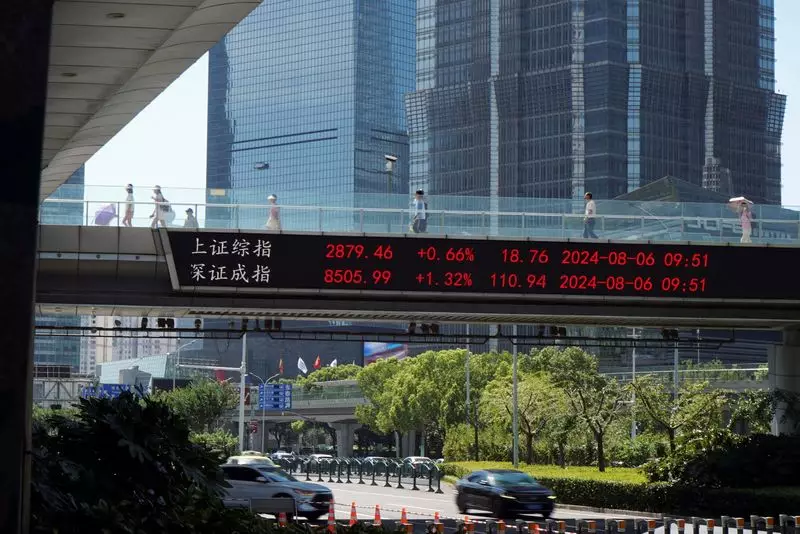As the Asian trading week commences, investors find themselves navigating a landscape fraught with mixed signals. The pervasive sentiment is one of reluctance, especially in light of disheartening economic data emerging from China. This disappointment contrasts sharply with the recent performance of U.S. markets, which experienced one of their strongest weeks in recent memory. Speculations abound regarding imminent interest rate cuts by the Federal Reserve, with hopes particularly centered around a significant cut of 50 basis points, which could have a profound impact on global market dynamics.
The S&P 500 has demonstrated remarkable resilience, closing in on its all-time high from July 15, while the Nasdaq posted an impressive weekly gain of 6%, marking its best performance since last October. Such momentum in the U.S. markets could serve as a much-needed lifeline for Asian investors looking for positive cues amidst a troubling economic backdrop. Meanwhile, market volatility appears to be on the decline, highlighted by a ‘MOVE’ index reflecting lower implied Treasury market volatility, suggesting a brief respite from market tumult.
However, the central focus remains firmly on China, which continues to grapple with significant economic challenges. Dismal news regarding inflation and deflationary pressures has left many investors skeptical about the future trajectory of the Chinese economy. Recent statistics reveal a staggering drop in new home prices, marking the steepest decline in nearly a decade. These contractions, accompanied by a slowdown in industrial output and a concerning 31.5% fall in foreign direct investment, portend ominous signals that cast a shadow over the broader economic outlook.
The reluctance of the Chinese authorities to implement necessary stimulus measures further complicates the situation. As capital inflows dwindle and outflows accelerate, the Chinese central bank is increasingly cornered into action to stabilize the yuan, which has fortuitously gained strength in recent weeks. Yet, the underlying economic indicators fail to support any notion of a robust recovery, raising alarms about the sustainability of this seemingly improved currency performance.
Global Trade and Political Tensions
Adding another layer of complexity to the Asian market situation is the international trade environment. Recent decisions by the Biden administration, specifically the imposition of steep tariff hikes on Chinese imports—including a notable 100% tariff on electric vehicles—have sparked significant backlash from Beijing. Chinese authorities have responded with a promise to safeguard the interests of local businesses, highlighting the delicate balance of power and the volatility within U.S.-China trade relations.
This tension is likely to influence investor sentiment in Asia, as the repercussions of these tariff decisions could lead to greater instability in trade dynamics across the region. Consequently, Asian markets may experience heightened fluctuations as stakeholders reassess their strategies in response to evolving geopolitical landscapes.
The coming week holds critical data releases that could further elucidate the market’s direction. Despite the turbulence, there are promising developments on the horizon, including inflation figures from Japan and Hong Kong, alongside pivotal monetary policy decisions from various countries, including Indonesia, Taiwan, China, and Japan. This week’s economic calendar will be instrumental for investors keen on deciphering the potential trajectories of Asian markets.
Moreover, the German wholesale price inflation data, coupled with the New York Fed manufacturing index reports, could provide additional clarity about the overall economic landscapes in Asia and the broader global environment. These indicators are, therefore, essential as analysts and investors alike brace for possible shifts in market sentiments, which could steer investment strategies in a rapidly changing context.
While the U.S. markets display optimism fueled by potential rate cuts, the Asian markets are confronted with significant hurdles, particularly from China. Investors will need to remain vigilant and adaptive, recognizing that the path ahead is laden with uncertainties that could significantly influence their investment decisions and strategies in the weeks to come.

